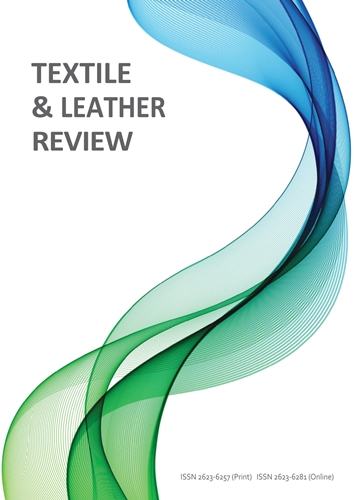Textile & Leather Review

- Status in HRČAK: stopped issuing on HRČAK
-
ISSN 2623-6257 (Tisak)
ISSN 2623-6281 (Online) -
UDK: 677+675
DOI: https://doi.org/10.31881/TLR - Contact:
Editorial Office
Ante Kovačića 4a, Donji Laduč
Editor-in-Chief - Dragana Kopitar
Assistant Editor - Ivana Schwarz
Managing Editor - Davor Jokić
Editorial Administrator - Paula Marasović - Email: editorial@tlr-journal.com
- URL: http://www.tlr-journal.com
- Publisher:
idd3
Ante Kovačića 4a, Donji Laduč
- Guidelines for authors
- Guidelines for references
- Impressum
- Publication Ethics and Malpractice Statement
- Article template
- Editorial board
Textile & Leather Review has an aim to disseminate a fundamental, theoretical and applied scientific knowledge related to textile and leather. Published articles present original research and advances across different disciplines including materials, technology, chemistry, economics and design related to the textile, leather, clothing and footwear industry. Journal topics include research of different textile materials such as fibres, yarns, textile fabrics, leather, as well as composites and other fibre-based materials for various applications. Furthermore, the focus is on the technology and processes of textile, leather, clothing and footwear industry, including chemical technologies and processes for textile and leather production. In addition, the Journal welcomes articles on diverse aspects such as environment, sustainability, innovation, waste management, marketing and management, quality, textile design, fashion theory, fashion industry and more. Textile & Leather Review publishes research, providing current information with the aim of stimulating the dissemination of research results in these fields. The variety of perspectives provides a holistic view of the science behind textile and leather.
- Peer review: peer review, international peer review, all papers, double blind review, double
- First year of publication: 2018.
- Frequency (annually): 4
- Scientific disciplines and subdisciplines: Interdisciplinary Technical Sciences, Textile Technology
- Date added to HRČAK: 21.06.2018.
- Rights: Open Access – Textile & Leather Review is a Diamond Open Access journal. There are no article processing (APC) or access charges. Journal applies the Creative Commons Attribution (CC BY-SA 4.0) license to published articles. This license was developed to facilitate open access – namely, free immediate access to original works of all types under the following terms. You are free to share (copy and redistribute the material in any medium or format) and adapt (remix, transform, and build upon the material) for any purpose, even commercially. Terms of use apply to attribution (You must give appropriate credit, provide a link to the license, and indicate if changes were made. You may do so in any reasonable manner, but not in any way that suggests the licensor endorses you or your use) and share alike (If you remix, transform, or build upon the material, you must distribute your contributions under the same license as the original). No additional restrictions — You may not apply legal terms or technological measures that legally restrict others from doing anything the license permits. Under this license (CC BY-SA 4.0), authors retain ownership of the copyright for their content, but allow anyone to download, reuse, reprint, modify, distribute and/or copy the content as long as the original authors and source are cited. No permission is required from the authors or the publishers. For an Appropriate attribution can be provided by simply citing the original article (e.g., Ceylan O. Knowledge, attitudes and behavior of consumers towards sustainability and ecological fashion. Textile & Leather Review. 2019,2(3);154-161. https://doi.org/10.31881/TLR.2019.14). For any reuse or redistribution of a work, users must also make clear the license terms under which the work was published. This broad license was developed to facilitate free access to, and unrestricted reuse of, original works of all types. Applying this standard license for your own work will ensure that it is freely and openly available in perpetuity. If you submit your article for publication by Textile & Leather Review, you agree to have the CC BY-SA 4.0 license applied to your work. Under this license, you as the author agree to make articles legally available for reuse, without permission or fees, for virtually any purpose. Anyone may copy, distribute, or reuse these articles, under stated terms of use. This facilitates freedom in re-use and also ensures that Textile & Leather Review content can be mined without barriers for the needs of research.
